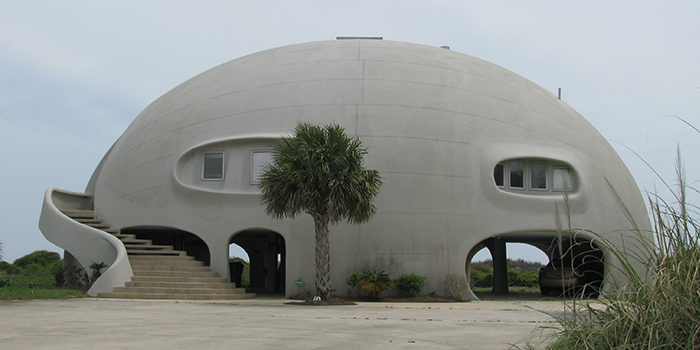
Monolithic Domes

Back to Education Center | Homeowners' Guide
Monolithic Domes are super-insulated, steel-reinforced
concrete structures used for virtually any type of structure, including: homes,
schools, gymnasiums, bulk storage facilities, churches, offices, and many other
uses. David B. South, president of the Monolithic Dome Institute, and his
brothers, Barry and Randy South, developed an efficient method for building a
strong dome using a continuous spray-in-place process. In 1976, after years of
planning and development, they built the first dome, a potato storage facility,
in Shelley, Idaho.
The Construction
Process
A Monolithic Dome starts as a circular concrete foundation,
reinforced with steel rebar. Vertical steel bars embedded along the perimeter
of the foundation are used to attach the steel rebar that will later reinforce the
dome itself.
The Airform–essentially a large balloon fabricated to the proper
shape and size of the structure–is attached to the concrete base. Using fans,
the Airform is inflated to create the shape of the dome. The Airform is both
the form for construction of the dome and functions as the outer roof membrane
of the shell when it is finished. The inflator fans run throughout the majority
of the construction process.
Approximately three inches of polyurethane foam insulation
are applied to the interior surface of the Airform. Usually, the foam is
applied in two or three stages, also called “lifts” or “passes.”
Later, steel rebar is attached to the foam using special hooks embedded in the foam. The rebar is placed in a specially engineered layout of a horizontal and vertical matrix.
Shotcrete, a special spray-applied concrete, is installed on the interior surface of the polyurethane foam, embedding the rebar. After three inches of shotcrete is applied, the Monolithic Dome is a steel reinforced, concrete structure.
When the concrete has cured, the inflator fans are turned off.
Monolithic Dome Benefits
The Monolithic Dome is a permanent structure that is energy efficient, cost effective, disaster resistant, and aesthetically distinct.
Monolithic Domes can withstand the force of a tornado, hurricane or earthquake. In fact, Monolithic Domes meet FEMA standards for offering “near-absolute protection” to occupants during natural disasters. Essentially, this designation means FEMA’s current body of knowledge suggests Monolithic Dome occupants are almost certainly guaranteed to survive natural disasters.
The Monolithic Dome is energy efficient because of the inherently minimal surface area relative to the volume of the structure. Basically, there is less surface area to transfer heat, compared to a normal boxy structure. Also, the domes’ seamless construction results in the elimination of virtually all sources of air leakage and infiltration. Monolithic Domes require roughly 50% of the energy consumption for heating and cooling compared to a comparable conventional building, per the Monolithic Dome Institute.






